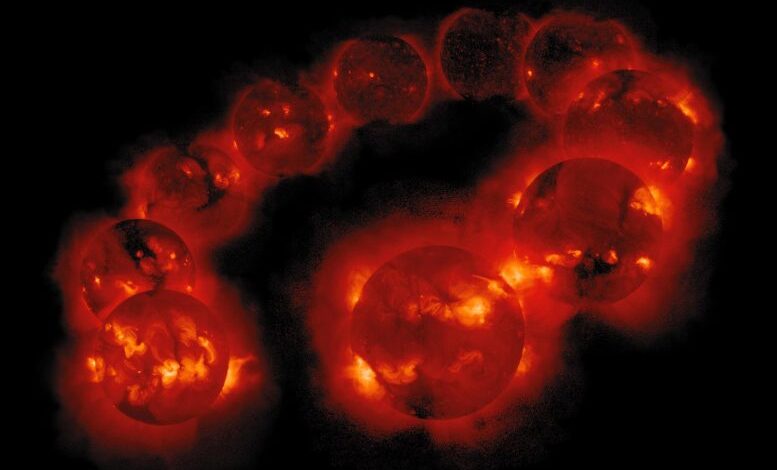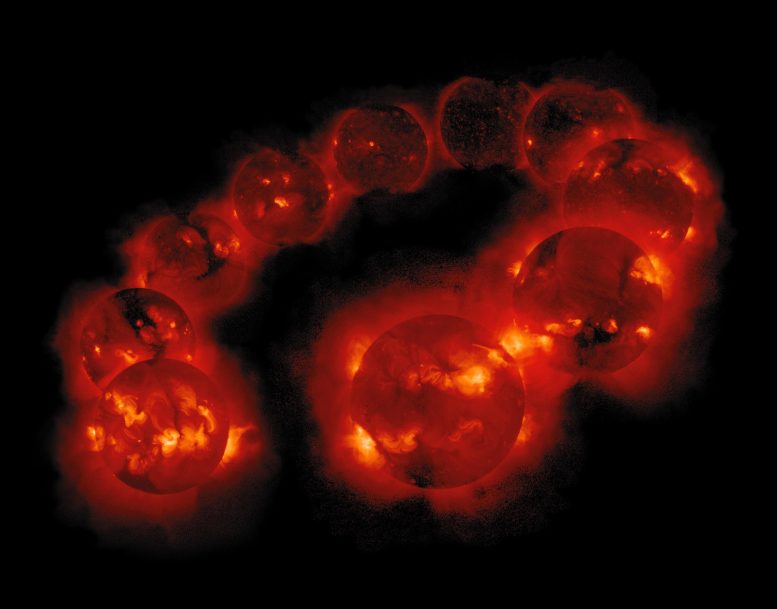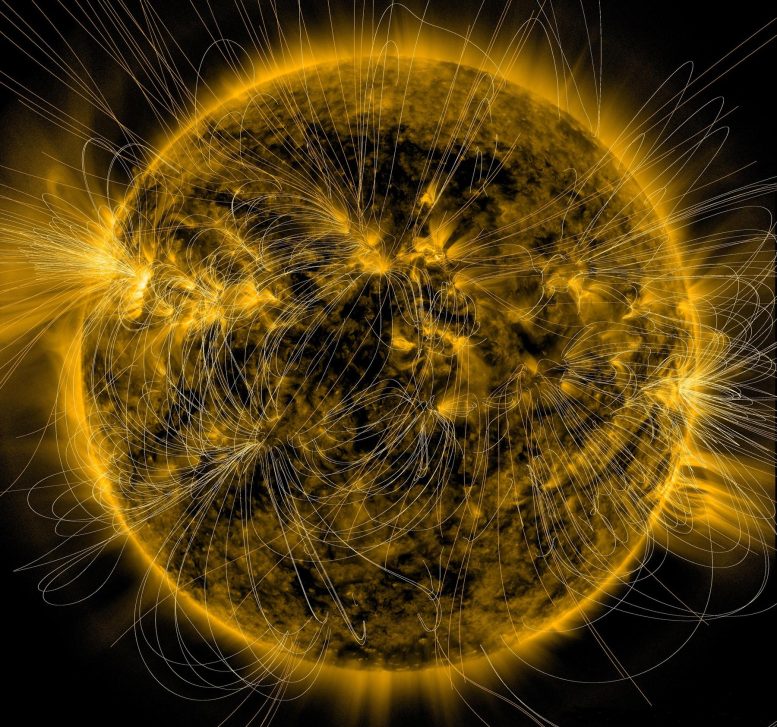Solar Physicists Uncover Surprising Shallow New Origins


Images of the sun over 10 years reveal how the star’s activity spikes and dips over time. Credit: The Yohkoh mission of ISAS, Japan, and NASA, United States
New research suggests the solar dynamo, responsible for solar cycles and sunspots, starts in the sun’s outer layers. This challenges older theories of a deeper origin and offers insights into the predictable patterns of solar activity.
A team of solar scientists has uncovered the possible originals of the engine that drives much of the sun’s volatile nature—generating the sunspots that move like storm clouds over the surface and causing the sun’s activity levels to rise and fall over 11-year cycles.
The secret behind this engine, also known as the “solar dynamo,” may be among the oldest “unsolved problems of physics,” said Benjamin Brown, a solar physicist at CU Boulder.
New Insights Into Solar Behavior
In their groundbreaking research, Brown and his colleagues used mathematical equations to simulate the behavior of the sun, arguing that the dynamo may begin in the star’s outermost layers—not deep in its interior as many scientists have believed for decades.
It’s a pursuit that, in many ways, started with the famed astronomer Galileo Galilei in 1612 A.D.

This illustration lays a depiction of the sun’s magnetic fields over an image captured by NASA’s Solar Dynamics Observatory. The complex overlay of lines can teach scientists about the ways the sun’s magnetism changes in response to the constant movement on and inside the sun. Credit: NASA/SDO/AIA/LMSAL
“Galileo first observed the sunspots 400 years ago, and he learned quite a bit about them, including how they move over the sun’s surface,” said Brown, a co-author of the research and associate professor in the Department of Astrophysical and Planetary Sciences. “But he couldn’t figure out where they came from. We’ve struggled with the question ever since.”
Historical Context and Current Findings
The researcher team, led by Geoffrey Vasil of the University of Edinburgh in the United Kingdom, published their findings recently in the journal Nature. Co-authors of the study included Keith Julien, an applied mathematician from CU Boulder who died in April after a short illness.
The findings hinge on the dynamo, the term for the complex physics and chemistry in the sun that produce its wild magnetic fields. Earth boasts its own dynamo that powers the planet’s magnetic field—the reason why all compasses on the ground point north.
The sun’s inner workings matter a lot for people, Brown said. The sun’s dynamo generates solar storms that, among other things, pose risks to human power grids. Such storms also caused the auroras that appeared in the skies above the United States earlier this month.
For the researchers, the study represents an achievement decades in the making.
“Geoff Vasil and I have been thinking about these ideas ever since we were both grad students at CU Boulder 20 years ago,” Brown said.
Solar Dynamo: Predictable Yet Chaotic
In general, scientists agree that the solar dynamo begins in the sun’s “convection zone,” or roughly the outer one-third of its interior. There, plumes of hot and charged particles, known as plasma, climb toward the surface.
While Earth’s magnetic field is mostly uniform, the churn of plasma throughout the sun’s convection zone warps and twists its magnetic field lines into a pattern that looks a like a bowl of noodles.
Despite that chaos, the solar dynamo powers behavior that is surprisingly predictable, Brown said. Every 11 years or so, the sun moves from a period of low activity, when sunspots pop up less often, to a period of frenzied activity, when sunspots abound—then it flips and starts all over again. Right now, the sun’s activity is on the frenzied side.
“You could practically set a calendar to the solar dynamo,” he said. “How is it so wild yet also so orderly?”
Spinning Dancers
To find out, researchers first need to know exactly where in the sun the dynamo begins. In the 1990s, scientists proposed that the dynamo emerged roughly 130,000 miles below the sun’s surface—a theory nicknamed the “dynamo in the deep.”
That notion, however, struggles to explain the order that emerges from the sun’s chaos. Instead, Vasil, Brown and their colleagues turned to a phenomenon in physics called a “magnetorotational instability.” It’s a sort of imbalance that forms whenever magnetic fields interact with rotating plasmas where those flows move faster as you go deeper.
“It’s kind of like dance partners slinging each other around in a spin while holding arms,” Brown said.
Researchers have long examined how this phenomenon arises in the disks of hot gases that circle black holes. Its role in the sun is less clear.
In the current study, Vasil, Brown, and their colleagues ran a series of calculations on computers to study how such an instability could influence the sun’s activity. They discovered that the process could easily whip up the sun’s insides to form the solar dynamo and explain how the 11-year cycles start. Those physics would also take place in the outer 10% of the sun, or a paltry 20,000 miles from the surface. The solar dynamo, in other words, might be powerful, but it’s also a little on the shallow side.
Future Directions and Legacy
The researchers have a lot of work to do before they can fully cast off the dynamo in the deep theory. But Brown is hopeful that the study could become its own dynamo—generating a wave of new research in the field.
Vasil added that the work is a testament to his colleague and friend, Julien.
As a doctoral student at CU Boulder, “My advisors and mentors were Nic Brummell, Juri Toomre, and Keith Julien,” Vasil said. “I recall first having a ‘huh, that’s funny’ moment about sun’s the near-surface instability one morning in 2004 while flipping through an astrophysics textbook. Keith was the first person I literally ran to tell about it. He was such a fantastic friend all these years. He supported ideas and gave encouragement to a generation of energetic young researchers, like I was back then. It’s astonishing he won’t be here anymore. But he was thrilled this work happened and was to be published in Nature. The silver lining is that his ideas and personality will live on in the astonishing number of people that he inspired over the years.”
For more on this research:
Reference: “The solar dynamo begins near the surface” by Geoffrey M. Vasil, Daniel Lecoanet, Kyle Augustson, Keaton J. Burns, Jeffrey S. Oishi, Benjamin P. Brown, Nicholas Brummell and Keith Julien, 22 May 2024, Nature.
DOI: 10.1038/s41586-024-07315-1

